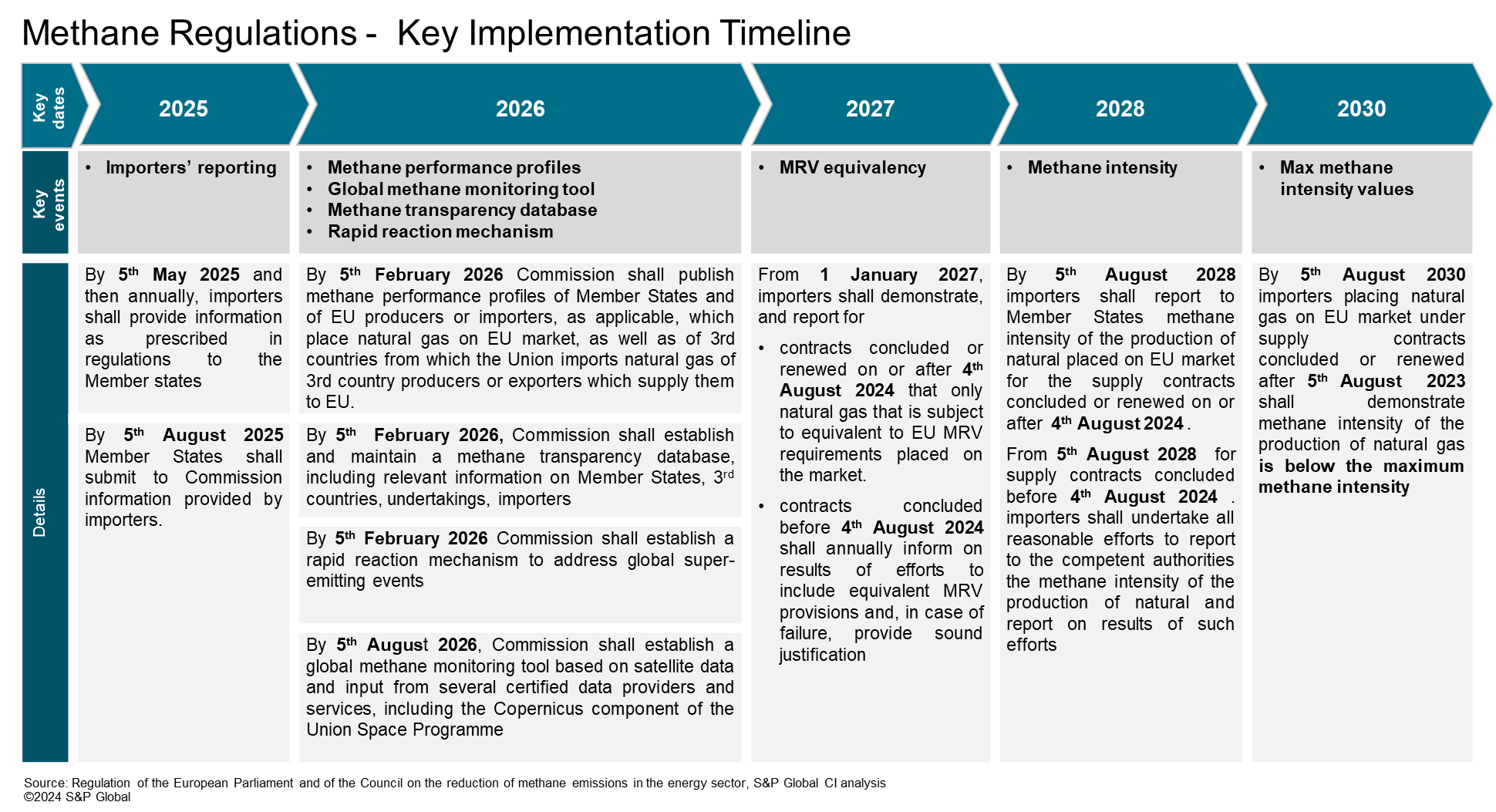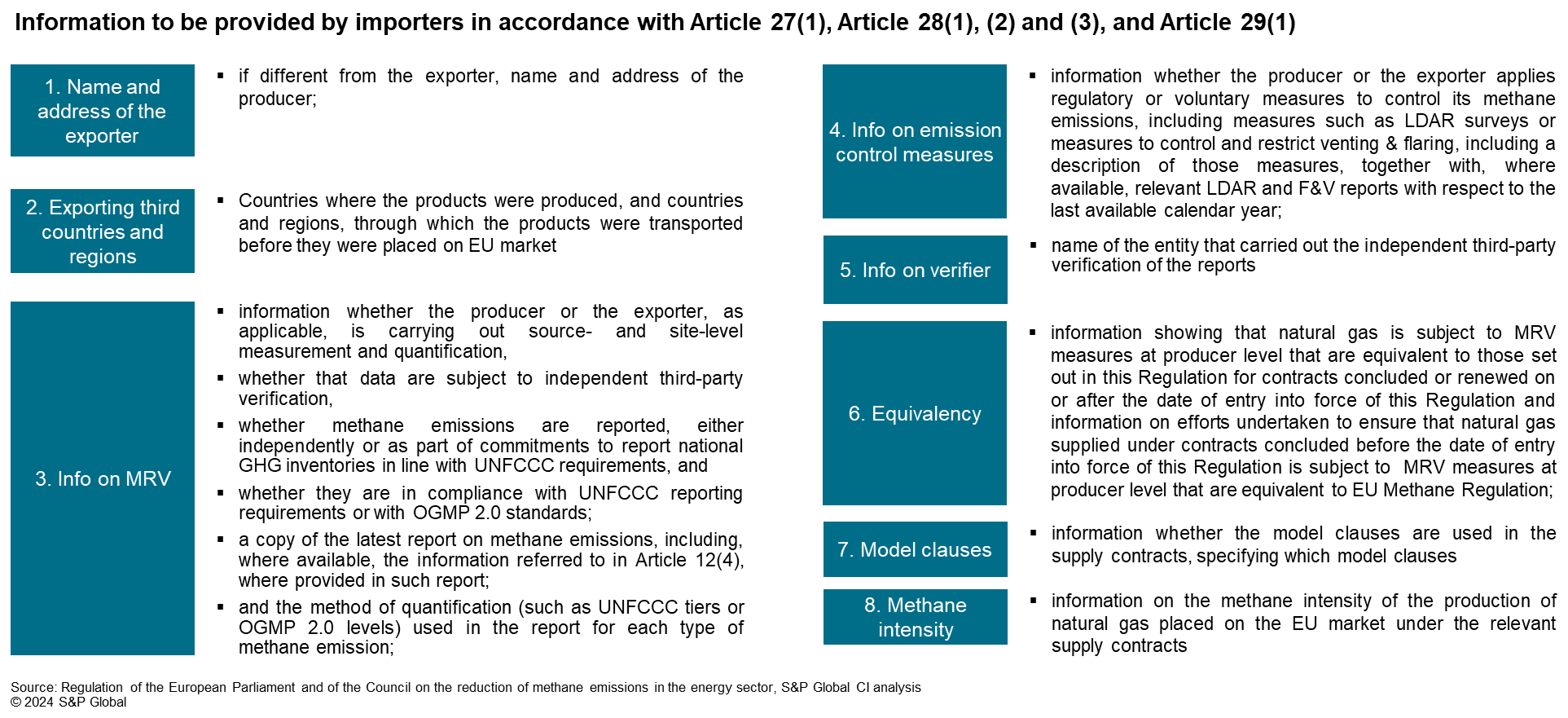Customer Logins
Obtain the data you need to make the most informed decisions by accessing our extensive portfolio of information, analytics, and expertise. Sign in to the product or service center of your choice.
Customer Logins
BLOG
Jul 31, 2024
EU Methane Emission Regulation: Key Provisions for Fossil Energy Importers and Third-Country Producers
The EU Regulation on the Reduction of Methane Emissions in the Energy Sector (the Regulation) was officially adopted by the European Council on May 27, 2024, and published on July 15 July, 2024. Within 20 days the Regulation enters into force.
The Regulation applies to EU Member States and companies operating in the EU member countries. However, recognizing that methane emissions are a transboundary problem, the Regulation also extends its reach extraterritorially, applying its provisions outside of the EU as well.
The requirements set forth in this Regulation aim to increase transparency of fossil energy imports into the EU (such as natural gas, oil and coal), to promote the broader adoption of methane emission reduction measures in the energy sector as well as to steer unification of comprehensive standards and guidelines for methane emissions measurement, reporting and verification (MRV).
The Regulation mandates importers of natural gas (as well as oil and coal) to provide information on measures related to methane emissions, including methane emissions measurement, reporting and verification (MRV) and mitigation practices adopted and used by 3rd countries (i.e. countries that are not EU Member States) natural gas producers.
Furthermore, under the Regulation the EU Commission will be required to establish a methane transparency database, methane performance profiles, a global methane monitoring tool, and a rapid reaction mechanism to address high-emitting events as well as to set the methodology for methane intensity and maximum methane intensity levels for different energy classes at the producer level.
Implementation Timeline:
Implementation of the Regulation is designed to be phased over a period of approximately 5 years with the key timeline as it applies to importers, 3rd countries and 3rd country's producers is summarised below:

Importers Information (Art. 26) and Methane Performance Profiles (Art. 30)
Importers Information
By May 5, 2025, and by May 31 every year thereafter, importers of fossil energy shall submit relevant information to the EU Member States where they are established.
The list of the required information is summarised in Annex 9 of the Regulation as provided below.

By August 5, 2025, and by 31 August of each subsequent year, EU Member States are required to submit the information received from the importers of fossil energy to the EU Commission.
Methane Performance Profiles
Based on the information collected from importers and EU Member States by February 5, 2026, EU Commission is required to commence publishing methane performance profiles of importers that place natural gas (as well as oil and coal) on EU market, as well as of 3rd countries from which the EU imports natural gas and of 3rd country producers or exporters which supply them to EU.
The methane performance profile will contain the following information:

Methane Transparency Database (Art. 30)
By February 5, 2026, EU Commission is required to launch a methane transparency database. This database will include relevant information on EU Member States, 3rd countries, undertakings, importers, volumes of natural gas, as well as oil and coal placed on the EU market.
With respect to 3rd countries that are not the EU Member States, the information to be contained in the database will includes the following:
- List of 3rd countries where natural gas (as well as oil and coal) is exported to the EU
- For each Member State, a list of importers of natural gas (as well as oil and coal)
- For every 3rd country whether a country:
- has mandatory (MRV) and methane mitigation regulatory measures;
- has signed the Paris Agreement and joined a Global Methane Pledge (GMP);
- submits national inventory reports required under United Nations Framework Convention on Climate Change (UNFCCC) and if these reports include tier 3 reporting;
- amount of methane emissions specified in national inventory reports and information on whether this data is independently verified;
- electronic links to national data sources;
- list of producers or exporters of natural gas into EU and whether they are part of any global initiatives for the reduction of methane emissions, such as the Oil and Gas Methane Partnership (OGMP) and the Zero Routine Flaring Initiative;
- indicative values estimating the methane emissions related to the transport of natural gas.
Rapid Reaction Mechanism and Global Methane Monitoring Tool (Art. 31)
By February 5, 2026, the EU Commission shall establish a rapid reaction mechanism to address super-emitting events.
Furthermore, the EU Commission is entiteled to promptly notify the EU Member State or 3rd country where the super-emitting event has occurred and where feasible the producer associated with the methane-emitting source or connected sources. The notification will request additional information about the super-emitting event and details on the remedial measures taken or planned. The EU Commission will keep the EU Parliament and the EU Council informed about the notifications of super-emitting events and the implementation of remedial measures.
The EU Commission will propose bilateral dialogues with 3rd countries from which EU imports natural gas, oil and coal. The aim is to establish a framework for information exchange and an early detection and warning system to identify and respond to super-emitting events and their remedial measures.
Global Methane Monitoring Tool (Art. 31)
By August 5, 2026, the EU Commission is required to launch a global methane monitoring tool that utilizes satellite data and input from various certified providers, including the Copernicus component of the Union Space Programme. The Commission may also leverage existing international tools and frameworks when available too.
This global methane monitoring tool will be publicly accessible, offering regular updates on the occurrence, magnitude, and location of significant methane emissions from energy sources both within and outside the EU.
MRV Equivalency and Exemptions (Art. 28)
The Regulation set forth requirements for new import contracts (concluded on or after 4 August 2024) for natural gas (as well as oil and coal) to require exporters to adhere to the same MRV requirements as those set for EU producers under this Regulation.
Additionally, natural gas importers are required to make every reasonable effort to ensure that existing contracts (concluded before 4th August 2024) for natural gas (as well as oil and coal) are also subject to MRV measures outlined in the Regulation.
Importers may be exempted from reporting obligations if they import natural gas from a country with an MRV regulatory framework equivalent to the EU's. This means the 3rd country shall apply similar MRV standards to its producers and exporters of natural gas (as well as oil and coal) as these applicable in the EU .

Methane Intensity Reporting and Maximum Methane Intensity Limits (Art. 29)
Methane Intensity
When the methane transparency database, performance profiles, global methane monitoring tool, and rapid reaction mechanism are put in place, the EU Commission by August 5, 2027, will develop and set in a delegated act a methodology for calculating the methane intensity of the production of natural gas placed on the EU market.
By August 5, 2028, importers will be required to report to EU Member States the methane intensity of natural gas production (as well as oil and coal) for all supply contracts that were concluded or renewed on or after August 4, 2024, in accordance with this established methodology.
Equally, starting on August 5, 2028, for supply contracts that were concluded before August 4, 2024, importers will be required to make every reasonable effort to report the methane intensity of natural gas (as well as oil and coal) production to the relevant authorities. They will also be required to provide a detailed account of the results of these efforts.
Maximum Methane Intensity Limits
The EU Commission will adopt delegated acts to set maximum methane intensity values associated with natural gas placed on the EU market at the level of the producer, based on the methodology for calculating the methane intensity of the production of natural gas (as well as oil and coal) and the assessment of the potential impact of establishing maximum methane intensity values.
Those values should be set at levels that promote the reduction of global methane emissions, while preserving the security of energy supply and protecting the competitiveness of EU economy.
By August 5, 2030 importers placing natural gas (as well as oil and coal) on the EU market under supply contracts concluded or renewed after August 5, 2030 shall demonstrate that the methane intensity of the production of natural gas (as well as oil and coal) is below the maximum methane intensity.
In conclusion, over time, gradual implementation the Regulation will have an impact on the 3rd countries and producers importing fossil energy into the EU in several ways:
- It will require 3rd countries or producers to use more rigorous EU comparable/equivalent MRV practices for methane emissions and implementation of methane abatement measures.
- By requiring detailed information on methane emissions from imported fossil fuels it will enhance transparency and help different actors to make informed decisions based on the available methane emissions data.
- For 3rd countries or producers not able to meet the regulatory requirements it may pose market access or market share maintenance risks.
The EU Commission will issue delegated acts, technical prescriptions and other documents to provide further detail and direction on how the Regulation will be fully implemented in the next 5 years.
For more information contact Yelena Shliomenzon.
This article was published by S&P Global Commodity Insights and not by S&P Global Ratings, which is a separately managed division of S&P Global.
{"items" : [
{"name":"share","enabled":true,"desc":"<strong>Share</strong>","mobdesc":"Share","options":[ {"name":"facebook","url":"https://www.facebook.com/sharer.php?u=http%3a%2f%2fstage.www.spglobal.com%2fcommodityinsights%2fen%2fci%2fresearch-analysis%2feu-regulation-on-the-reduction-of-methane-emissions-in-the-ene.html","enabled":true},{"name":"twitter","url":"https://twitter.com/intent/tweet?url=http%3a%2f%2fstage.www.spglobal.com%2fcommodityinsights%2fen%2fci%2fresearch-analysis%2feu-regulation-on-the-reduction-of-methane-emissions-in-the-ene.html&text=EU+Methane+Emission+Regulation%3a+Key+Provisions+for+Fossil+Energy+Importers+and+Third-Country+Producers+%7c+S%26P+Global+","enabled":true},{"name":"linkedin","url":"https://www.linkedin.com/sharing/share-offsite/?url=http%3a%2f%2fstage.www.spglobal.com%2fcommodityinsights%2fen%2fci%2fresearch-analysis%2feu-regulation-on-the-reduction-of-methane-emissions-in-the-ene.html","enabled":true},{"name":"email","url":"?subject=EU Methane Emission Regulation: Key Provisions for Fossil Energy Importers and Third-Country Producers | S&P Global &body=http%3a%2f%2fstage.www.spglobal.com%2fcommodityinsights%2fen%2fci%2fresearch-analysis%2feu-regulation-on-the-reduction-of-methane-emissions-in-the-ene.html","enabled":true},{"name":"whatsapp","url":"https://api.whatsapp.com/send?text=EU+Methane+Emission+Regulation%3a+Key+Provisions+for+Fossil+Energy+Importers+and+Third-Country+Producers+%7c+S%26P+Global+ http%3a%2f%2fstage.www.spglobal.com%2fcommodityinsights%2fen%2fci%2fresearch-analysis%2feu-regulation-on-the-reduction-of-methane-emissions-in-the-ene.html","enabled":true}]}, {"name":"rtt","enabled":true,"mobdesc":"Top"}
]}


